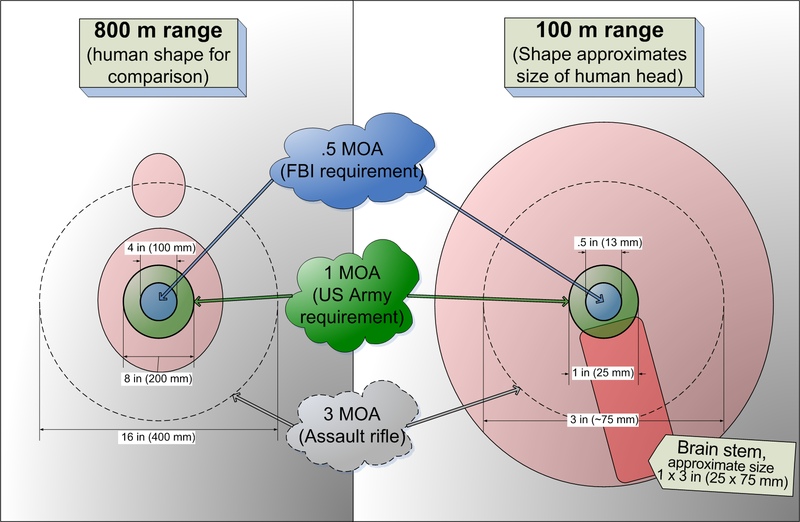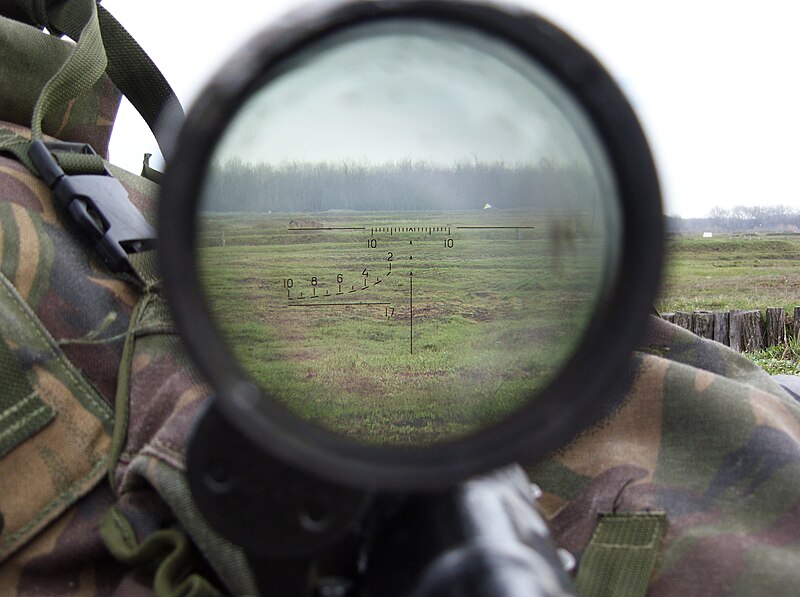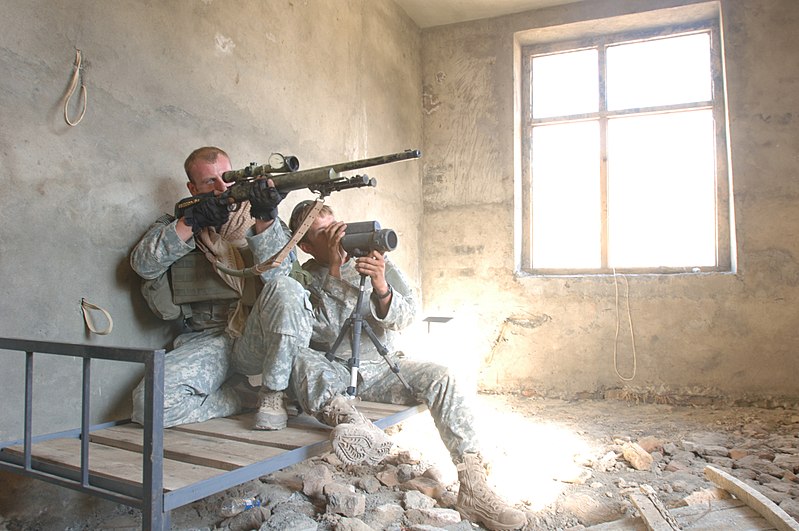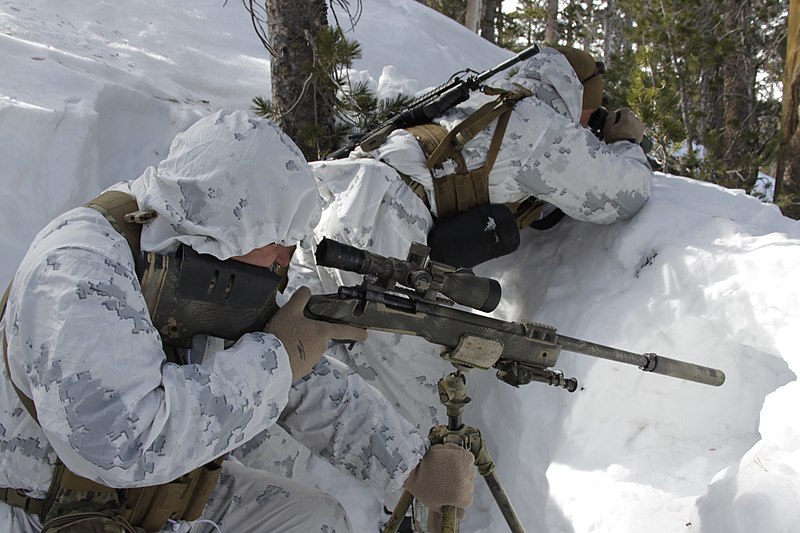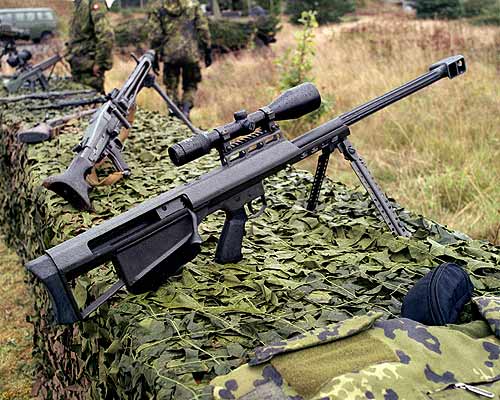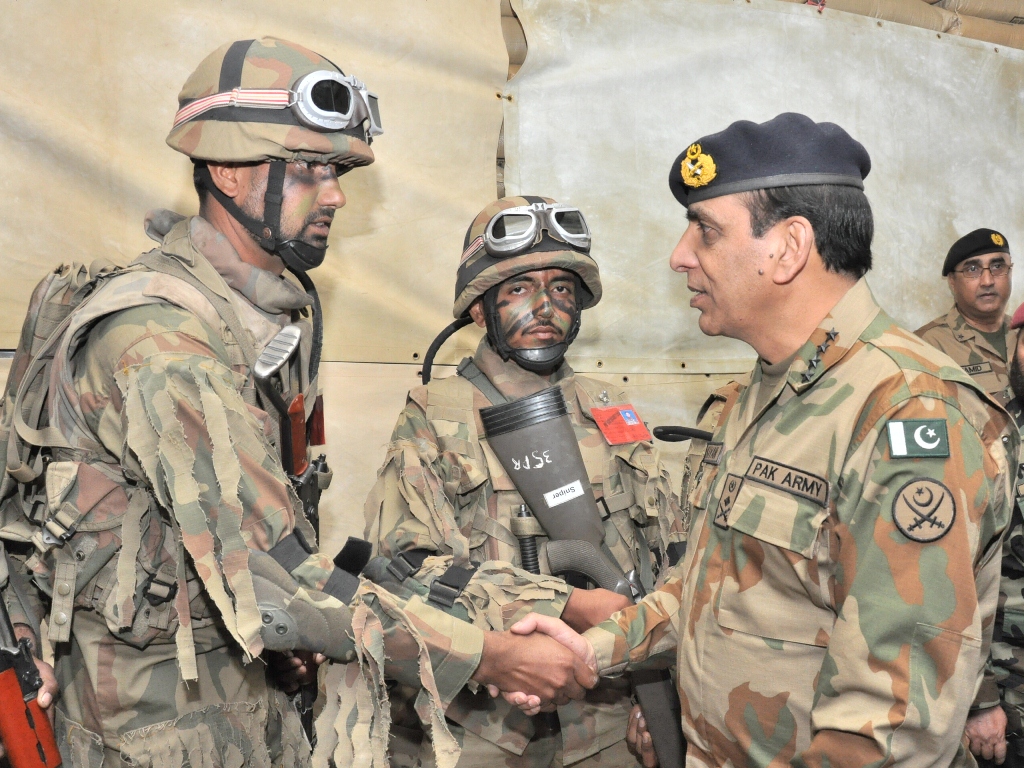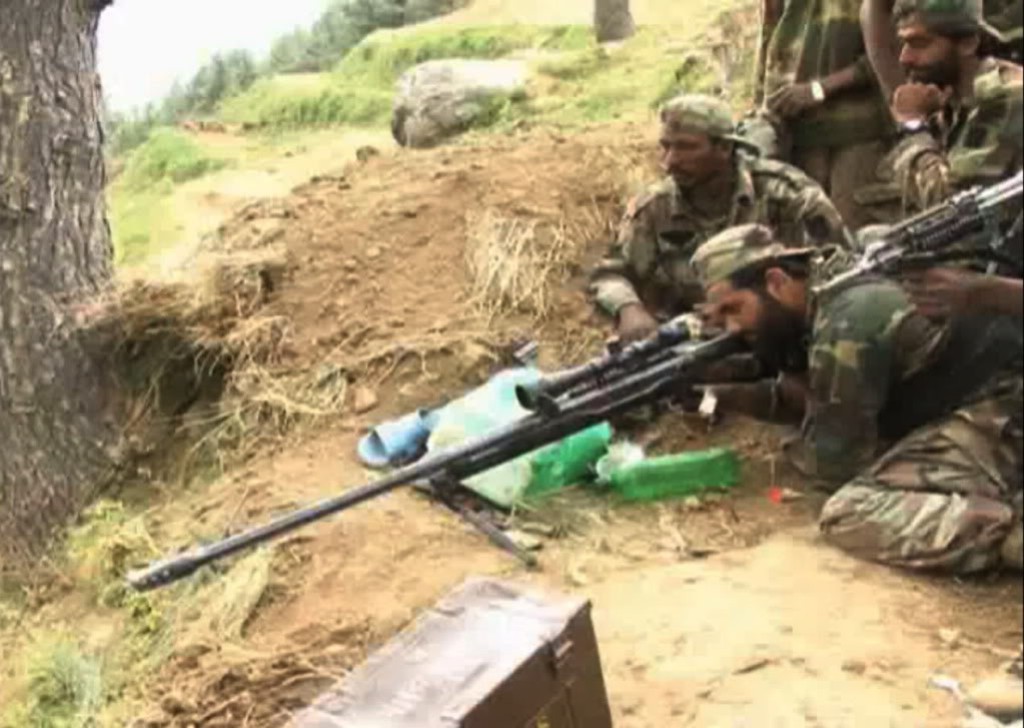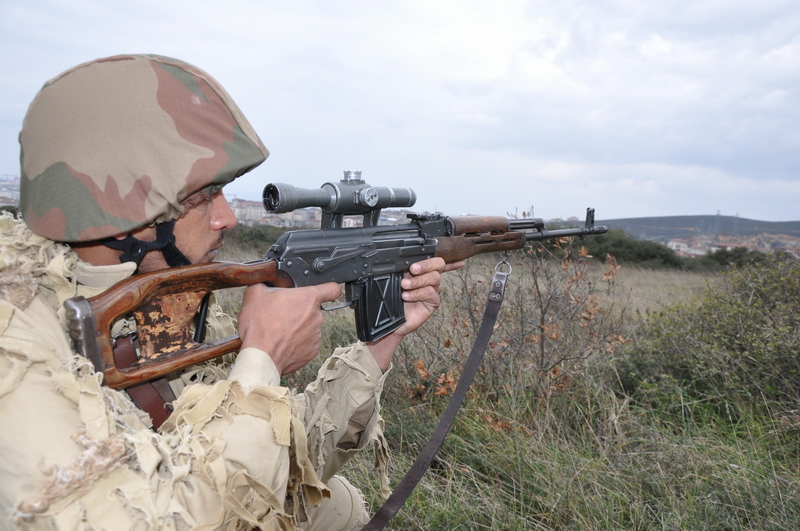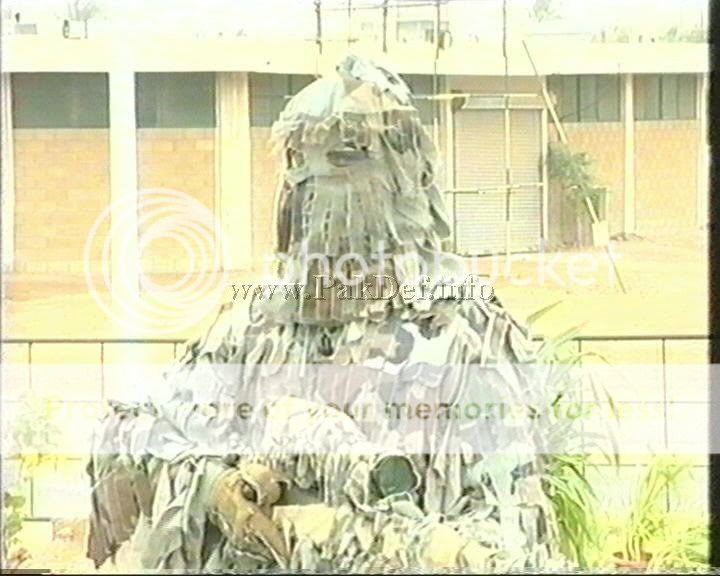Jango
SENIOR MODERATOR

- Joined
- Sep 12, 2010
- Messages
- 21,530
- Reaction score
- 99
- Country
- Location
Introduction:
A sniper rifle is a precision-rifle used to ensure more accurate placement of bullets at longer ranges than other small arms.The main purpose of the sniper rifle is to destroy valuable targets at extended ranges with aimed fire, and with as few ammunition as possible. In most cases, "the target" means the human being (enemy soldier, armed criminal, terrorist, president etc.), and the "as few ammunition as possible" often means "one shot". The range for sniper fire may vary from 100 meters or even less in police/counter-terror scenarios, or up to 1 kilometer or more - in military or special operations scenarios.
Some sniper rifles, mostly - large caliber ones, used also as anti-material weapons, to destroy, or, more often, render unusable or unoperable, targets such as radar cabins, jeeps, parked aircrafts etc.
A typical sniper rifle is built for optimal levels of accuracy, fitted with a telescopic sight and chambered for a military centerfire cartridge. The term is often used in the media to describe any type of accurized firearm fitted with a telescopic sight that is employed against human targets, although "sniping rifle" or "sniper's rifle" is the technically correct term for such a rifle.
The military role of a sniper (a term derived from the snipe, a bird which was difficult to hunt and shoot) dates back to the turn of the 18th century, but the true sniper rifle is a much more recent development. Advances in technology, specifically that of telescopic sights and more accurate manufacturing, allowed armies to equip specially trained soldiers with rifles that enable them to deliver precise shots over greater distances than regular infantry weapons. The rifle itself could be based on a standard rifle (at first, a bolt-action rifle); however, when fitted with a telescopic sight, it becomes a sniper rifle.History of sharp-shooting traces its ancestry well back into XIX or even into XVIII centuries. Early sniper rifles were standart issue army rifles, selected for accuracy, or privately purchased commercial target or hunting rifles. During WW I and WW II both sides used a lot of general issue bolt action rifles (such a Russian/Soviet Mosin M1991/30, US M1903A4, British SMLE No.4(t), German G98k etc.) fitted with some kind of telescopic sight. Some of general issued semi-auto rifles also were used in sniper role, such as Soviet SVT-40 and US M1 Garand.
Classification:
Sniper rifles can be broadly separated into two categories as below.
Military Sniper rifles: As the name suggest, used by different military units. Along with main requirements for accuracy and sufficient effective range, military use commands some other: military sniper rifle must not be too heavy, because sniper usually must carry it for the long hours, with ammunition and other stuff. Also, military sniper rifle must be extremely reliable in any weather and climatic conditions and could withstand hundreds of rounds fired without cleaning and maintenance and without any loss of accuracy. Third, military sniper rifle must be easy to field-strip and easy to repair in field conditions. Also, military sniper rifle often must have backup iron sights, in case of telescope breakage.
Another requirement is that military sniper rifle must use military ammunition, conforming to international war treaties and generally available to the troops. In most cases, military sniper rifle use variants of the standard caliber army cartridges (such as 7.62mm NATO or 7.62x54mm R), specially developed for sniping.
Effective range for the standard-caliber sniper rifles against the single human-sized target may be estimated as 700-800 meters for first-shot kills. To extend effective range beyond 1000 meters, often used sniper rifles, designed to fire more powerful ammunition, such as .300 Winchester magnum (7.62x67mm) or .338 Lapua magnum (8.6x70mm).
Military sniper rifles may be further separated in two tactically different categories: the sniper rifles itself, designed to achieve aimed hits at long distances, and the Designated Marksman Rifles (DMR), designed to provide accurate fire support for line troops. While the "true" sniper rifles usually are bolt action ones, to achieve maximum accuracy, the DMRs usually are semi-autos, such as Russian SVD or German G3ZF or MSG-90, to gain higher rate of fire. But the difference lays more in tactical appliances, than in the rifles itself.
Law Enforcement: Sniper rifles built or modified for use in law enforcement are generally required to have the greatest possible accuracy, more than military rifles, but do not need to have as long a range.
As law enforcement-specific rifles are usually used in non-combat (often urban) environments, they do not have the requirement to be as hardy or portable as military versions; nevertheless they may be smaller, as they do not need very long range.
The majority of Law Enforcement or Counter Terrorism scenarios require precision shooting at the distances lesser that 300, or even 100 meters. These scenarios also require really few shots per scenario - sometimes one and the only one shot. This also require extreme accuracy and stability of results in any weather conditions. LE and CT snipers also has no limitations on caliber and ammunition selection, so they could select almost any caliber/cartridge they department want, or can afford.
Characteristic features:
Sniper rifles have some distinctive features which separate them form other normal rifles and weapons.
Telescope sight:
The single most important characteristic that sets a sniper rifle apart from other military or police small arms is the mounting of a telescopic sight, which is relatively easy to distinguish from smaller optical aiming devices found on some modern assault rifles and submachine guns. This also allows the user to see farther.
The telescopic sights used on sniper rifles differ from other optical sights in that they offer much greater magnification (more than 4× and up to 40×), and have a much larger objective lens (40 to 50 mm in diameter) for a brighter image.
Most telescopic lenses employed in military or police roles have special reticles to aid with judgment of distance, which is an important factor in accurate shot placement due to the bullet's trajectory.

PSO-1 Sniper Scope Reticle
1 - Lead/deflection scale
2 - Main targeting chevron
3 - Bullet drop chevrons
4 - Rangefinder

Action:
The choice between bolt-action and semi-automatic (more commonly known as recoil or gas operation) is usually determined by specific requirements of the sniper's role as envisioned in a particular organization, with each design having advantages and disadvantages. For a given cartridge, a bolt-action rifle is cheaper to build and maintain, more reliable, and lighter, due to fewer moving parts in the mechanism. In addition, the absence of uncontrolled automatic cartridge case ejection helped to avoid revealing the firer's position. Semi-automatic weapons can serve both as battle rifle and sniper rifle, and allow for a greater rate (and hence volume) of fire. As such rifles may be modified service rifles, an additional benefit can be commonality of operation with the issued infantry rifle. A bolt action is most commonly used in both military and police roles due to its higher accuracy and ease of maintenance. Anti-materiel applications such as mine clearing and special forces operations tend to use semi-automatics.
A designated marksman rifle (DMR) is less specialized than a typical military sniper rifle, often only intended to extend the range of a group of soldiers. Therefore, when a semi-automatic action is used it is due to its ability to cross over into roles similar to the roles of standard issue weapons. There may also be additional logistical advantages if the DMR uses the same ammunition as the more common standard issue weapons. These rifles enable a higher volume of fire, but sacrifice some long range accuracy. They are frequently built from existing selective fire battle rifles or assault rifles, often simply by adding a telescopic sight and adjustable stock.
So in short, it is a trade off. If you want to have a high rate of fire you choose a semi-auto, while if you want to have long range, and be covert, you use a bolt action.
Barrel:
Barrels are normally of precise manufacture and of a heavier cross section than more traditional barrels in order to reduce the change in impact points between a first shot from a cold barrel and a follow-up shot from a warm barrel. Unlike many battle and assault rifles, the bores are usually not chromed to avoid inaccuracy due to an uneven treatment.
When installed, barrels are often free-floated: i.e., installed so that the barrel only contacts the rest of the rifle at the receiver, to minimise the effects on impact point of pressure on the fore-end by slings, bipods, or the sniper's handsSniper-rifle barrels may also utilise a threaded muzzle or combination device (muzzle brake or flash suppressor and attachment mount) to allow the fitting of a sound suppressor. These suppressors often have a means of adjusting the point of impact while fitted.
Military sniper rifles tend to have barrel lengths of 609.6 mm (24 inches) or longer, to allow the cartridge propellant to fully burn, reducing the amount of revealing muzzle flash and increasing bullet velocity.
Cartridges:
To achieve a significantly longer range than the usual 7.62 x 51 requires at least a larger cartridge case to generate a much higher muzzle energy, and preferably a larger calibre as well; other things being equal, heavy large-calibre bullets retain their velocity better and are less affected by cross-winds. This was recognised by the first attempts to fire accurately at very long range which often used anti-tank rifles of 13-14.5 mm calibre. In fact, as early as the Great War the 13 mm Mauser M1918 anti-tank rifle was used in the counter-sniping role, although in this case the motivation was not so much to achieve long range as to punch through the armour plates being used to protect Allied snipers. The Korean War saw Soviet 14.5 mm PTRD rifles being used for long-range fire, as well as, on the US side, some experiments with .50 BMG guns. However, the guns were usually not that accurate and, even if they were, the standard production MG ammunition certainly wasn't.
A change came in the 1980s from two different sources in the USA. One was the adoption of long-range anti-materiel rifles in .50 BMG calibre, not primarily for sniping but for attacking vehicles and other inanimate objects, normally using standard API or (later) Multipurpose MG ammunition. The other was the establishment of the .50 Caliber Shooters Association, promoting the use of this calibre for long-range civilian shooting, which inspired much more accurate rifles and ammunition. In combination, these two developments led to the use of .50 BMG rifles for long-range sniping as well as anti-materiel use.
There is a problem, however: the .50 BMG rifles and their ammunition are necessarily very big and heavy, not ideal for the sniping role. Many believed that a smaller, but still powerful, calibre would do that job more efficiently. As a result, specialised long-range sniping rifles are now available in several competing calibres, with the widely-adopted .338 Lapua Magnum being the clear market leader, followed by the .300 Winchester Magnum. The ones described in this article are those offered in military-type sniper rifles; there is a host of "wildcats" (rounds made by individual experimenters) in addition. Furthermore, some anti-materiel rifles are also offered in the Russian heavy machine-gun calibres of 12.7 x 108 and 14.5 x 114, but these will not be considered here.
A high muzzle velocity is an advantage in long-range sniping, but that alone is not enough. As ranges extend, it is the ability of the bullet to retain its velocity which becomes increasingly important; bullets which slow down gradually are far more useful than those which rapidly shed velocity. To achieve this, the bullet needs a high ballistic coefficient (BC). This is achieved partly by using a bullet of exceptionally streamlined shape, and partly by making it heavy. It is worthwhile sacrificing some muzzle velocity in order to use a bullet with a higher BC.
The key yardstick for long-range sniper ammunition is the range at which the bullet drops below the speed of sound. This is important for two reasons. The first is because that provides a quick proxy for the trajectory and time of flight of the bullet; and the flatter the trajectory and the shorter the flight time, the greater the hit probability, other things being equal. The second is that dropping back through the transonic zone usually disturbs the flight of the bullet, adversely affecting accuracy, although this effect is minimised with the very low drag bullets developed for the more specialised calibres. To give an example, the 7.62 x 51 147 grain M80 standard NATO ball bullet is fired at a muzzle velocity 200 fps higher than the 175 grain M118LR, but drops to subsonic velocity at around 875 m compared with about 950 m for the heavier and initially slower bullet.
Some of the cartridges for sniping in use today are:
.300 Winchester Magnum, .338 Norma Magnum, .338 Lapua Magnum, 9.3 x 64 Russian, .375 Cheyenne Tactical, .408 Cheyenne Tactical, .50 Browning Machine Gun (BMG), 5.56x45mm NATO, 6.16x51mm.

From left to right:
7.62x51 (for scale), .300 Winchester Magnum, .308 Norma Magnum, .338 Lapua Magnum, 9x85 MEN, 9.3x64 Russian, .375 CheyTac, .408 CheyTac (Extreme Performance loading), .416 Tyr (Extreme Performance loading), .416 Barrett, .460 Steyr, .50 BMG (Primetake loading).
A sniper rifle is a precision-rifle used to ensure more accurate placement of bullets at longer ranges than other small arms.The main purpose of the sniper rifle is to destroy valuable targets at extended ranges with aimed fire, and with as few ammunition as possible. In most cases, "the target" means the human being (enemy soldier, armed criminal, terrorist, president etc.), and the "as few ammunition as possible" often means "one shot". The range for sniper fire may vary from 100 meters or even less in police/counter-terror scenarios, or up to 1 kilometer or more - in military or special operations scenarios.
Some sniper rifles, mostly - large caliber ones, used also as anti-material weapons, to destroy, or, more often, render unusable or unoperable, targets such as radar cabins, jeeps, parked aircrafts etc.
A typical sniper rifle is built for optimal levels of accuracy, fitted with a telescopic sight and chambered for a military centerfire cartridge. The term is often used in the media to describe any type of accurized firearm fitted with a telescopic sight that is employed against human targets, although "sniping rifle" or "sniper's rifle" is the technically correct term for such a rifle.
The military role of a sniper (a term derived from the snipe, a bird which was difficult to hunt and shoot) dates back to the turn of the 18th century, but the true sniper rifle is a much more recent development. Advances in technology, specifically that of telescopic sights and more accurate manufacturing, allowed armies to equip specially trained soldiers with rifles that enable them to deliver precise shots over greater distances than regular infantry weapons. The rifle itself could be based on a standard rifle (at first, a bolt-action rifle); however, when fitted with a telescopic sight, it becomes a sniper rifle.History of sharp-shooting traces its ancestry well back into XIX or even into XVIII centuries. Early sniper rifles were standart issue army rifles, selected for accuracy, or privately purchased commercial target or hunting rifles. During WW I and WW II both sides used a lot of general issue bolt action rifles (such a Russian/Soviet Mosin M1991/30, US M1903A4, British SMLE No.4(t), German G98k etc.) fitted with some kind of telescopic sight. Some of general issued semi-auto rifles also were used in sniper role, such as Soviet SVT-40 and US M1 Garand.
Classification:
Sniper rifles can be broadly separated into two categories as below.
Military Sniper rifles: As the name suggest, used by different military units. Along with main requirements for accuracy and sufficient effective range, military use commands some other: military sniper rifle must not be too heavy, because sniper usually must carry it for the long hours, with ammunition and other stuff. Also, military sniper rifle must be extremely reliable in any weather and climatic conditions and could withstand hundreds of rounds fired without cleaning and maintenance and without any loss of accuracy. Third, military sniper rifle must be easy to field-strip and easy to repair in field conditions. Also, military sniper rifle often must have backup iron sights, in case of telescope breakage.
Another requirement is that military sniper rifle must use military ammunition, conforming to international war treaties and generally available to the troops. In most cases, military sniper rifle use variants of the standard caliber army cartridges (such as 7.62mm NATO or 7.62x54mm R), specially developed for sniping.
Effective range for the standard-caliber sniper rifles against the single human-sized target may be estimated as 700-800 meters for first-shot kills. To extend effective range beyond 1000 meters, often used sniper rifles, designed to fire more powerful ammunition, such as .300 Winchester magnum (7.62x67mm) or .338 Lapua magnum (8.6x70mm).
Military sniper rifles may be further separated in two tactically different categories: the sniper rifles itself, designed to achieve aimed hits at long distances, and the Designated Marksman Rifles (DMR), designed to provide accurate fire support for line troops. While the "true" sniper rifles usually are bolt action ones, to achieve maximum accuracy, the DMRs usually are semi-autos, such as Russian SVD or German G3ZF or MSG-90, to gain higher rate of fire. But the difference lays more in tactical appliances, than in the rifles itself.
Law Enforcement: Sniper rifles built or modified for use in law enforcement are generally required to have the greatest possible accuracy, more than military rifles, but do not need to have as long a range.
As law enforcement-specific rifles are usually used in non-combat (often urban) environments, they do not have the requirement to be as hardy or portable as military versions; nevertheless they may be smaller, as they do not need very long range.
The majority of Law Enforcement or Counter Terrorism scenarios require precision shooting at the distances lesser that 300, or even 100 meters. These scenarios also require really few shots per scenario - sometimes one and the only one shot. This also require extreme accuracy and stability of results in any weather conditions. LE and CT snipers also has no limitations on caliber and ammunition selection, so they could select almost any caliber/cartridge they department want, or can afford.
Characteristic features:
Sniper rifles have some distinctive features which separate them form other normal rifles and weapons.
Telescope sight:
The single most important characteristic that sets a sniper rifle apart from other military or police small arms is the mounting of a telescopic sight, which is relatively easy to distinguish from smaller optical aiming devices found on some modern assault rifles and submachine guns. This also allows the user to see farther.
The telescopic sights used on sniper rifles differ from other optical sights in that they offer much greater magnification (more than 4× and up to 40×), and have a much larger objective lens (40 to 50 mm in diameter) for a brighter image.
Most telescopic lenses employed in military or police roles have special reticles to aid with judgment of distance, which is an important factor in accurate shot placement due to the bullet's trajectory.

PSO-1 Sniper Scope Reticle
1 - Lead/deflection scale
2 - Main targeting chevron
3 - Bullet drop chevrons
4 - Rangefinder

Action:
The choice between bolt-action and semi-automatic (more commonly known as recoil or gas operation) is usually determined by specific requirements of the sniper's role as envisioned in a particular organization, with each design having advantages and disadvantages. For a given cartridge, a bolt-action rifle is cheaper to build and maintain, more reliable, and lighter, due to fewer moving parts in the mechanism. In addition, the absence of uncontrolled automatic cartridge case ejection helped to avoid revealing the firer's position. Semi-automatic weapons can serve both as battle rifle and sniper rifle, and allow for a greater rate (and hence volume) of fire. As such rifles may be modified service rifles, an additional benefit can be commonality of operation with the issued infantry rifle. A bolt action is most commonly used in both military and police roles due to its higher accuracy and ease of maintenance. Anti-materiel applications such as mine clearing and special forces operations tend to use semi-automatics.
A designated marksman rifle (DMR) is less specialized than a typical military sniper rifle, often only intended to extend the range of a group of soldiers. Therefore, when a semi-automatic action is used it is due to its ability to cross over into roles similar to the roles of standard issue weapons. There may also be additional logistical advantages if the DMR uses the same ammunition as the more common standard issue weapons. These rifles enable a higher volume of fire, but sacrifice some long range accuracy. They are frequently built from existing selective fire battle rifles or assault rifles, often simply by adding a telescopic sight and adjustable stock.
So in short, it is a trade off. If you want to have a high rate of fire you choose a semi-auto, while if you want to have long range, and be covert, you use a bolt action.
Barrel:
Barrels are normally of precise manufacture and of a heavier cross section than more traditional barrels in order to reduce the change in impact points between a first shot from a cold barrel and a follow-up shot from a warm barrel. Unlike many battle and assault rifles, the bores are usually not chromed to avoid inaccuracy due to an uneven treatment.
When installed, barrels are often free-floated: i.e., installed so that the barrel only contacts the rest of the rifle at the receiver, to minimise the effects on impact point of pressure on the fore-end by slings, bipods, or the sniper's handsSniper-rifle barrels may also utilise a threaded muzzle or combination device (muzzle brake or flash suppressor and attachment mount) to allow the fitting of a sound suppressor. These suppressors often have a means of adjusting the point of impact while fitted.
Military sniper rifles tend to have barrel lengths of 609.6 mm (24 inches) or longer, to allow the cartridge propellant to fully burn, reducing the amount of revealing muzzle flash and increasing bullet velocity.
Cartridges:
To achieve a significantly longer range than the usual 7.62 x 51 requires at least a larger cartridge case to generate a much higher muzzle energy, and preferably a larger calibre as well; other things being equal, heavy large-calibre bullets retain their velocity better and are less affected by cross-winds. This was recognised by the first attempts to fire accurately at very long range which often used anti-tank rifles of 13-14.5 mm calibre. In fact, as early as the Great War the 13 mm Mauser M1918 anti-tank rifle was used in the counter-sniping role, although in this case the motivation was not so much to achieve long range as to punch through the armour plates being used to protect Allied snipers. The Korean War saw Soviet 14.5 mm PTRD rifles being used for long-range fire, as well as, on the US side, some experiments with .50 BMG guns. However, the guns were usually not that accurate and, even if they were, the standard production MG ammunition certainly wasn't.
A change came in the 1980s from two different sources in the USA. One was the adoption of long-range anti-materiel rifles in .50 BMG calibre, not primarily for sniping but for attacking vehicles and other inanimate objects, normally using standard API or (later) Multipurpose MG ammunition. The other was the establishment of the .50 Caliber Shooters Association, promoting the use of this calibre for long-range civilian shooting, which inspired much more accurate rifles and ammunition. In combination, these two developments led to the use of .50 BMG rifles for long-range sniping as well as anti-materiel use.
There is a problem, however: the .50 BMG rifles and their ammunition are necessarily very big and heavy, not ideal for the sniping role. Many believed that a smaller, but still powerful, calibre would do that job more efficiently. As a result, specialised long-range sniping rifles are now available in several competing calibres, with the widely-adopted .338 Lapua Magnum being the clear market leader, followed by the .300 Winchester Magnum. The ones described in this article are those offered in military-type sniper rifles; there is a host of "wildcats" (rounds made by individual experimenters) in addition. Furthermore, some anti-materiel rifles are also offered in the Russian heavy machine-gun calibres of 12.7 x 108 and 14.5 x 114, but these will not be considered here.
A high muzzle velocity is an advantage in long-range sniping, but that alone is not enough. As ranges extend, it is the ability of the bullet to retain its velocity which becomes increasingly important; bullets which slow down gradually are far more useful than those which rapidly shed velocity. To achieve this, the bullet needs a high ballistic coefficient (BC). This is achieved partly by using a bullet of exceptionally streamlined shape, and partly by making it heavy. It is worthwhile sacrificing some muzzle velocity in order to use a bullet with a higher BC.
The key yardstick for long-range sniper ammunition is the range at which the bullet drops below the speed of sound. This is important for two reasons. The first is because that provides a quick proxy for the trajectory and time of flight of the bullet; and the flatter the trajectory and the shorter the flight time, the greater the hit probability, other things being equal. The second is that dropping back through the transonic zone usually disturbs the flight of the bullet, adversely affecting accuracy, although this effect is minimised with the very low drag bullets developed for the more specialised calibres. To give an example, the 7.62 x 51 147 grain M80 standard NATO ball bullet is fired at a muzzle velocity 200 fps higher than the 175 grain M118LR, but drops to subsonic velocity at around 875 m compared with about 950 m for the heavier and initially slower bullet.
Some of the cartridges for sniping in use today are:
.300 Winchester Magnum, .338 Norma Magnum, .338 Lapua Magnum, 9.3 x 64 Russian, .375 Cheyenne Tactical, .408 Cheyenne Tactical, .50 Browning Machine Gun (BMG), 5.56x45mm NATO, 6.16x51mm.
From left to right:
7.62x51 (for scale), .300 Winchester Magnum, .308 Norma Magnum, .338 Lapua Magnum, 9x85 MEN, 9.3x64 Russian, .375 CheyTac, .408 CheyTac (Extreme Performance loading), .416 Tyr (Extreme Performance loading), .416 Barrett, .460 Steyr, .50 BMG (Primetake loading).


